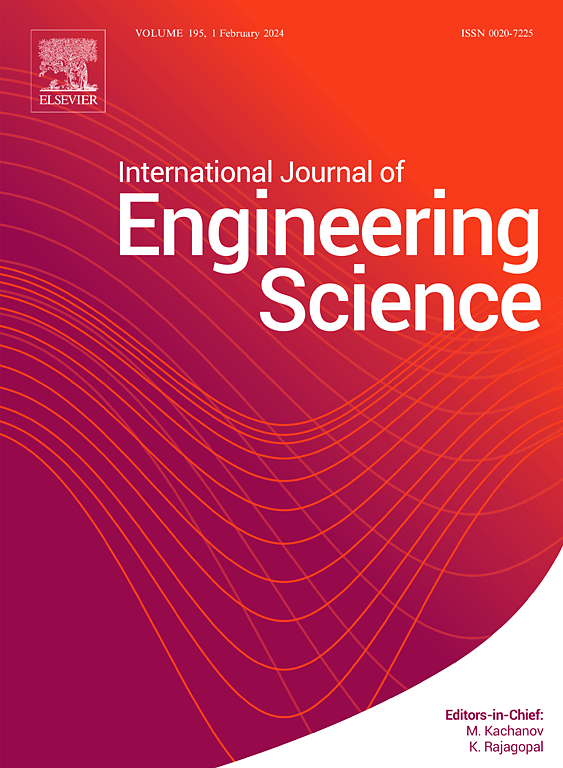液体和膜之间的拔河
IF 5.7
1区 工程技术
Q1 ENGINEERING, MULTIDISCIPLINARY
International Journal of Engineering Science
Pub Date : 2025-10-08
DOI:10.1016/j.ijengsci.2025.104395
引用次数: 0
摘要
预测初始应力膜在液体自重作用下的变形行为是非常重要的。实验观察表明,在液体与膜的拉锯战中,哪一方获胜并不取决于液体的体积。然而,现有的模型无法解释这种违反直觉的现象。为了理解这些意想不到的特征背后的潜在力学,我们提出了一个理论模型来推导膜-液体相互作用的配置。将线性膜理论与构型相关载荷相结合,导出了一维和二维轴对称膜挠度的解析解。这些解决方案产生了与实验非常一致的三种构型的定量预测。值得注意的是,我们发现一个关于液体密度、系统大小和膜张力的无量纲参数控制着膜-液竞争的强度。该模型为研究流固耦合系统开辟了一个新的视角。本文章由计算机程序翻译,如有差异,请以英文原文为准。
Tug-of-war between liquids and membranes
Predicting the deformation behavior of an initially stressed membrane subjected to liquid self-weight is nontrivial. Experimental observation indicates that in the tug-of-war competition between liquids and membranes, which side will prevail does not depend on the liquid volume. However, the existing models cannot explain this counterintuitive phenomenon. With the aim of understanding the underlying mechanics behind those unexpected features, we propose a theoretical model for deriving the configuration of membrane–liquid interactions. The analytical solutions for one-dimensional and two-dimensional axisymmetric membrane deflections are derived by combining the linear membrane theory and configuration-dependent loading. These solutions yield quantitative predictions for the three types of configuration that are in excellent agreement with the experiments. Remarkably, we find that a dimensionless parameter concerning the liquid density, the size of the system, and the membrane tension controls the intensity of the membrane–liquid competition. Our model opens up a new perspective for studying fluid–structure interaction systems.
求助全文
通过发布文献求助,成功后即可免费获取论文全文。
去求助
来源期刊

International Journal of Engineering Science
工程技术-工程:综合
CiteScore
11.80
自引率
16.70%
发文量
86
审稿时长
45 days
期刊介绍:
The International Journal of Engineering Science is not limited to a specific aspect of science and engineering but is instead devoted to a wide range of subfields in the engineering sciences. While it encourages a broad spectrum of contribution in the engineering sciences, its core interest lies in issues concerning material modeling and response. Articles of interdisciplinary nature are particularly welcome.
The primary goal of the new editors is to maintain high quality of publications. There will be a commitment to expediting the time taken for the publication of the papers. The articles that are sent for reviews will have names of the authors deleted with a view towards enhancing the objectivity and fairness of the review process.
Articles that are devoted to the purely mathematical aspects without a discussion of the physical implications of the results or the consideration of specific examples are discouraged. Articles concerning material science should not be limited merely to a description and recording of observations but should contain theoretical or quantitative discussion of the results.
 求助内容:
求助内容: 应助结果提醒方式:
应助结果提醒方式:


